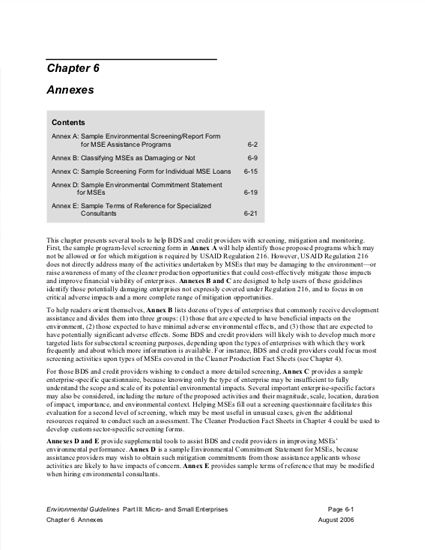Speeches Shim
![]() (82k) MSE Annexes (2006)
(82k) MSE Annexes (2006)
This chapter presents several tools to help BDS and credit providers with screening, mitigation and monitoring. First, the sample program-level screening form in Annex A will help identify those proposed programs which may not be allowed or for which mitigation is required by USAID Regulation 216. However, USAID Regulation 216 does not directly address many of the activities undertaken by MSEs that may be damaging to the environment—or raise awareness of many of the cleaner production opportunities that could cost-effectively mitigate those impacts and improve financial viability of enterprises. Annexes B and C are designed to help users of these guidelines identify those potentially damaging enterprises not expressly covered under Regulation 216, and to focus in on critical adverse impacts and a more complete range of mitigation opportunities.
To help readers orient themselves, Annex B lists dozens of types of enterprises that commonly receive development assistance and divides them into three groups: (1) those that are expected to have beneficial impacts on the environment, (2) those expected to have minimal adverse environmental effects, and (3) those that are expected to have potentially significant adverse effects. Some BDS and credit providers will likely wish to develop much more targeted lists for subsectoral screening purposes, depending upon the types of enterprises with which they work frequently and about which more information is available. For instance, BDS and credit providers could focus most screening activities upon types of MSEs covered in the Cleaner Production Fact Sheets (see Chapter 4).
For those BDS and credit providers wishing to conduct a more detailed screening, Annex C provides a sample enterprise-specific questionnaire, because knowing only the type of enterprise may be insufficient to fully understand the scope and scale of its potential environmental impacts. Several important enterprise-specific factors may also be considered, including the nature of the proposed activities and their magnitude, scale, location, duration of impact, importance, and environmental context. Helping MSEs fill out a screening questionnaire facilitates this evaluation for a second level of screening, which may be most useful in unusual cases, given the additional resources required to conduct such an assessment. The Cleaner Production Fact Sheets in Chapter 4 could be used to develop custom sector-specific screening forms.
Annexes D and E provide supplemental tools to assist BDS and credit providers in improving MSEs’ environmental performance. Annex D is a sample Environmental Commitment Statement for MSEs, because assistance providers may wish to obtain such mitigation commitments from those assistance applicants whose activities are likely to have impacts of concern. Annex E provides sample terms of reference that may be modified when hiring environmental consultants.


Comment
Make a general inquiry or suggest an improvement.